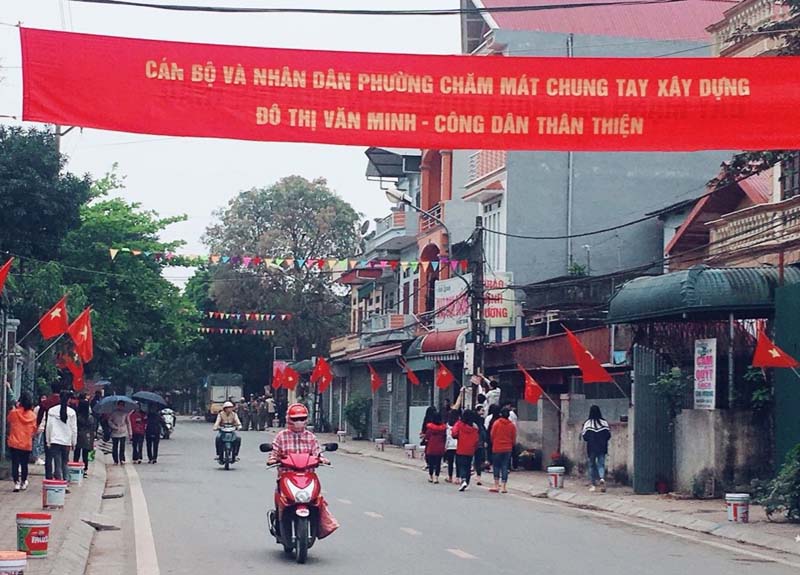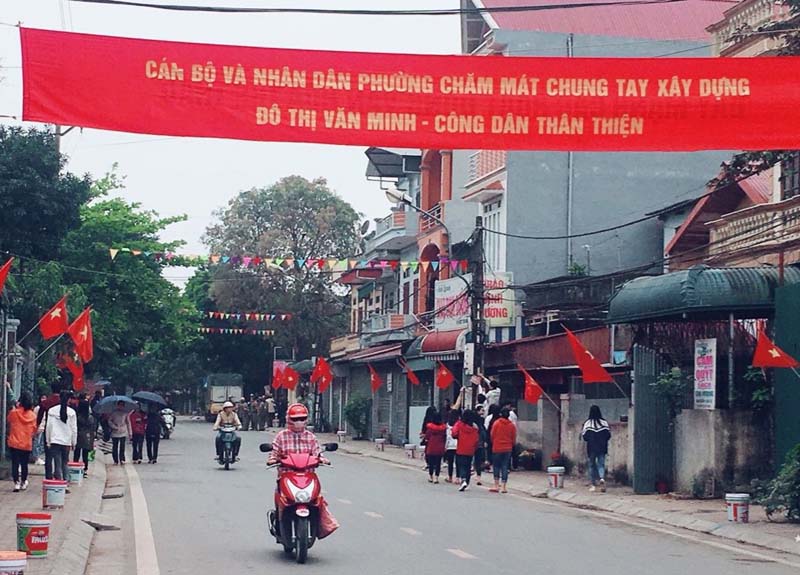
(HBO) - Towards the goal of building Hoa Binh City into a civilized and modern city imbued with a cultural identity of Hoa Binh, the Party Committee and the city government have directed the departments, the units and the enterprises throughout to seriously implement the movement "All people unite to build a cultural life”.

The streets in the Cham Ward (now Dan Chu
Ward – Hoa Binh City) are decorated in response to the movement of building the
civilized urban area.
Accordingly, the movement of emulation
towards a bright - green - clean - beautiful urban area has also been
effectively implemented by the city. The activities such as the Green Saturday,
the autonomous road, the civilized streets, the garbage-free residential areas,
the green Sunday... have been responded by the departments, the units and the
local people and have been effectively implemented in the residential areas.
Currently, 100% of wards and communes have implemented the green Saturday.
There are nearly 100 routes which have been self-governed by the young and
women. 100% of the schools in the area have built the cultural school gates...
Currently, the city is continuing to expand the model of "civilized streets and
the residential areas without garbage”. Thereby, the rate of the population
providing garbage collection and treatment services has reached 95% and the
proportion of medical waste treated in the locality has reached 100%.
In order to encourage and promote the
movement "All people unite to build a cultural life,” at the end of January
2020, the People's Committee of the City issued the Decision No.89/QD-UBND to
recognize the title "The departments, the units and the enterprises reaching
the cultural standards” in 2019. Accordingly, 215 departments, units and
enterprises in the city were recognized to meet the standards of cultural
departments, units and enterprises.
With an increasingly vibrant and widespread emulation movement aimed at building cultured residential areas and cultured families, Yen Thuy District has been making steady progress toward improving both the material and spiritual well-being of its people, while fostering a civilized, prosperous, beautiful, and progressive community.
Once lacking recreational spaces and community facilities, Residential Group 2 in Quynh Lam Ward (Hoa Binh City) has recently received attention for the construction of a new, spacious, and fully equipped cultural house. The project followed the model of state support combined with public contributions in both labor and funding.
The "All people unite to build cultural life" movement, which has been effectively integrated with Kim Boi district’s socio-economic development goals, is fostering a lively spirit of emulation across local residential areas, hamlets, villages, public agencies, and enterprises. In addition, through the initiative, traditional cultural values are being preserved and promoted, while community solidarity and mutual support in poverty reduction and economic development are being strengthened.
A working delegation of the Hoa Binh provincial People’s Committee led by its Permanent Vice Chairman Nguyen Van Toan on June 11 inspected the progress of a project to build the Mo Muong Cultural Heritage Conservation Space linked to tourism services in Hop Phong commune, Cao Phong district.
Born and growing in the heroic land of Muong Dong, Dinh Thi Kieu Dung, a resident in Bo town of Kim Boi district, in her childhood was nurtured by the sweet lullabies of her grandmother and mother. These melodies deeply imprinted on her soul, becoming an inseparable part of her love for her ethnic group's culture. For over 20 years, this love for her hometown has driven Dung to research, collect, and pass down the cultural values of the Muong people to future generations.
In the final days of May, the Ethnic Art Troupe of Hoa Binh Province organized performances to serve the people in remote, mountainous, and particularly disadvantaged areas within the province. These were not just ordinary artistic shows, but they were the meaningful journeys aimed at spreading cultural values, enhancing the spiritual life of the people and contributing to the preservation of ethnic minority cultural identities.



